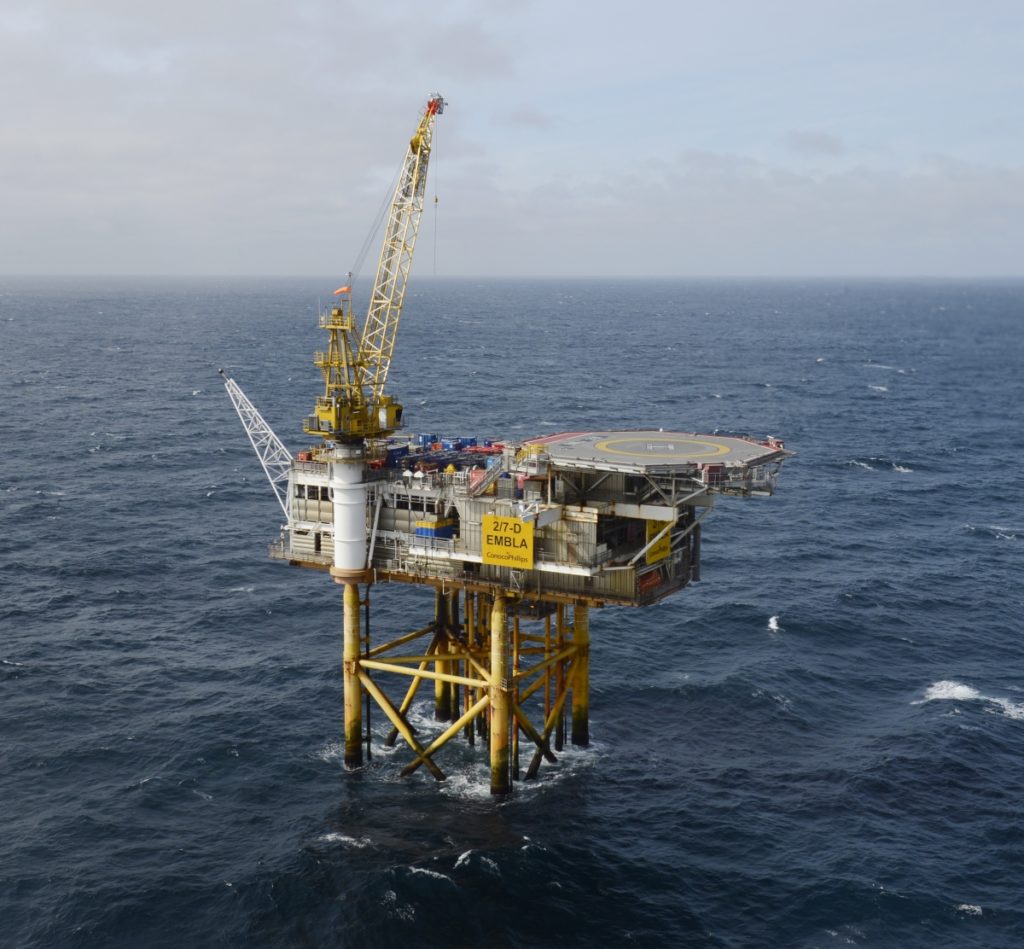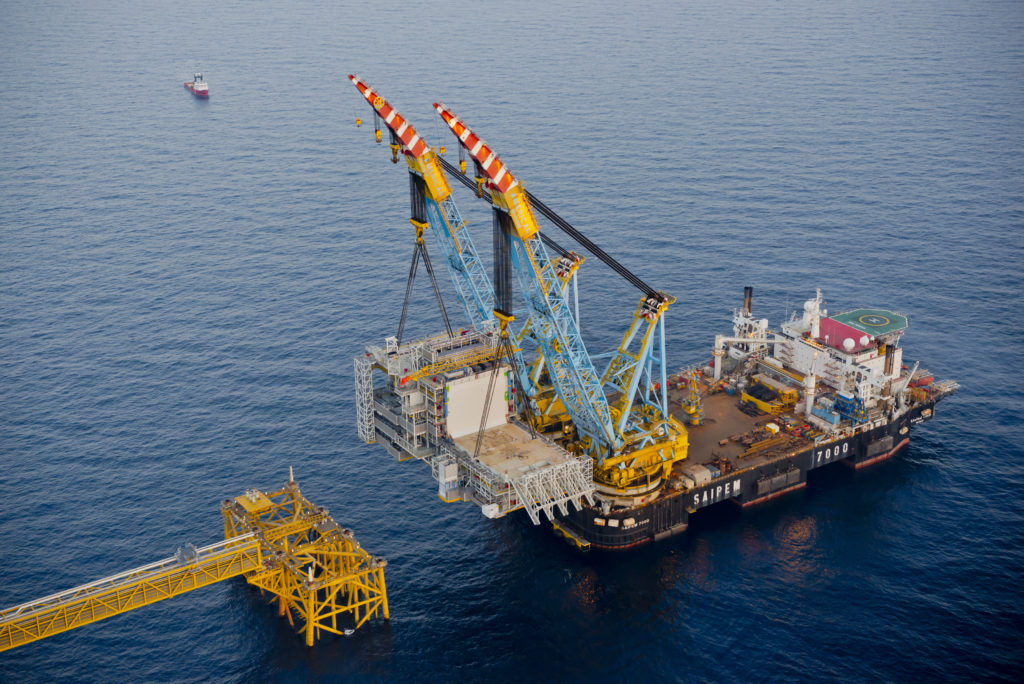Ekofisk in a nutshell

The three are operated by ConocoPhillips on behalf of the Ekofisk licensees. The area also embraces former producers Albuskjell, Cod, Edda, Tor, West Ekofisk and Tommeliten G.
These fields all lie within production licence 018 apart from Tommeliten G, which was operated by Statoil from 1976 to 2003.
In all, 31 installations have been positioned in the Greater Ekofisk Area.
First Norwegian offshore field
Ekofisk began production on 15 June 1971, following its discovery in the autumn of 1969. Development of the field has occurred in several phases.
Its central facilities were installed during the early 1970s, with oil initially being buoy-loaded into tankers. From 1975, it has been piped to Teesside in the UK. The gas has been landed by pipeline at Emden in Germany from 1977.
 ekofisk i et nøtteskall, engelsk
ekofisk i et nøtteskall, engelskJacked up six metres
The water depth in the Greater Ekofisk Area is 70-75 metres. However, declining pressure in the Ekofisk reservoir over the years has caused the seabed to subside.
Efforts began as early as 1985 to safeguard the installations against the effects of this development, and the steel platforms in the Ekofisk Complex were jacked up by six metres in 1987.
In addition, a protective breakwater was installed around the Ekofisk tank in 1989. The rate of seabed subsidence has declined sharply in recent years.
Waterflooding improves recovery
The Ekofisk 2/4 K water injection platform became operational in December 1987 as part of efforts to improve Ekofisk’s recovery factor – the share of petroleum in place actually produced.
Waterflooding capacity on the field to help maintain reservoir pressure was later expanded several times, and had reached just over 500 000 barrels per day by 2019.
Measured in barrels of oil equivalent, the recovery factor on Ekofisk has risen from an original estimate of 17 per cent to over 50 per cent.
Ekofisk I and II plus licence extension
The first phase of development and production on Ekofisk began with initial oil output from the converted Gulftide jack-up rig in 1971 and ended with the start-up of Ekofisk II in 1998.
Large parts of the Greater Ekofisk Area were restructured in the latter year, leading to plans for removing 15 installations – 14 steel platforms and the process facilities on the Ekofisk tank.
 plattformer, historie, 2004, driftsenter åpnet,
plattformer, historie, 2004, driftsenter åpnet,Designated Ekofisk I, these redundant structures include Ekofisk 2/4 A, 2/4 B, 2/4 FTP, 2/4 Q, 2/4 H, 2/4 R, 2/4 P and 2/4 T.
In addition come the Edda 2/7 C, Albuskjell 1/6 A, Albuskjell 2/4 F, Cod 7/11 A, West Ekofisk 2/4 D, Norpipe 36/22 A and Norpipe 37/4 A installations.
The concrete part of the tank – Ekofisk 2/4 T – will remain. Gulftide was removed as far back as 1974. Two platforms owned by other companies – Ekofisk 2/4 G and 2/4 S – have also gone.
A new plan for development and operation (PDO) of the field (Ekofisk II) was approved in 1994, at the same time as the Ekofisk licence was extended to 2028.
This creates a new Ekofisk Complex with two structures – the Ekofisk 2/4 X wellhead unit installed in the autumn of 1996 and the Ekofisk 2/4 J processing and transport platform in 1997.
Ekofisk II became operational in August 1998 and is intended to produce until 2028. Ekofisk, Eldfisk and Embla are tied back to the new complex, as was Tor until it shut down in December 2015.
Ekofisk West
 historie, forsidebilde, 2003, ekofisk vekst godkjent i statsråd
historie, forsidebilde, 2003, ekofisk vekst godkjent i statsrådIn December 2002, soon after the Conoco-Phillips merger had been announced, the Ekofisk West project was presented to improve oil and gas recovery. Process capacity and reliability on Ekofisk were also to be enhanced.
This development primarily involved the construction and installation of a new platform, Ekofisk 2/4 M, with processing facilities and 24 new wells drilled over five years.
The latter could contribute to improved recovery both because there were more wells and because they would tap new locations in the reservoir. On stream in 2005, 2/4 M was linked to the Ekofisk Complex with a bridge.
Process capacity for produced water was also to be increased through upgrading on Ekofisk 2/4 J and Eldfisk 2/7 E. A third measure concerned laying a power cable from the Ekofisk Complex to 2/4 K in order to make electricity supplies more efficient.
New developments: Eldfisk II and Ekofisk South
 Eldfisk 2/7 S løft
Eldfisk 2/7 S løftThe plan for development and operation (PDO) of Eldfisk II, approved by the Storting (parliament) on 9 June 2011, includes a new wellhead, process and accommodation platform – Eldfisk 2/7 S.
In addition come 42 new wells as well as upgrades to existing platforms which extend their commercial life.
The PDO for Ekofisk South involves the construction of a new wellhead platform – Ekofisk 2/4 Z – as well as a new subsea water injection facility and 44 additional wells.
Sources:
ConocoPhillips Norge, 2004.
Ministry of Petroleum and Energy, press release, “Vekstprosjekt på Ekofisk godkjent”, 6 June 2003.
https://www.stortinget.no/no/Saker-og-publikasjoner/Saker/Sak/?p=50343
https://www.stortinget.no/globalassets/pdf/innstillinger/stortinget/2010-2011/inns-201011-398.pdf
https://www.regjeringen.no/no/aktuelt/klart-for-40-nye-ar-pa-ekofisk-feltet/id642376/)
